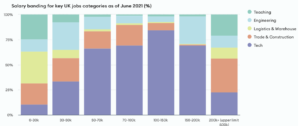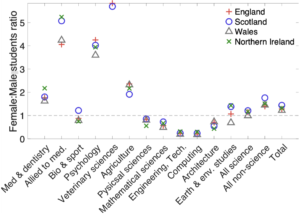There are disproportionately few women enrolling for undergraduate degrees in computing in the UK. Despite constituting 50.5% of the UK population and 57% of college graduates in the UK, only 19% of the technology workforce are women. The statistics for staff within our school align well with the national figures, with women constituting 56% of our professional services staff but only 20% of our academic staff. The disparity is lower in our student population: 27% of taught students (24.2% of undergraduates and 36% of post-graduate) and 22% of research students identified as female.
The decisions made by pupils in the last two years of high school is a key contributor to this disparity. The female to male ratio for first year STEM undergraduates across the UK hovers around 1, but its breakdown across disciplines reveals wide variation across the sciences (Figure 2 shows a detailed breakdown for interested readers). About one in four Computer Science (or Engineering) undergraduates identifies as female. Those who identified as ‘other’ when given a 3-way choice of gender (about 0.4% of UK’s population) make up about 0.2% of first year undergraduates in the UK; within our school the numbers are significantly better than the national average (0.7% of taught students and 2% of research students).
Most of the interventions designed and delivered in the UK [2,3], to reduce gender disparity in STEM, have been targeted at high school students. Specifically, focussing on female pupils to educate them about the benefits of choosing careers in science, via mechanisms such as the Stimulating Physics Network [1]. It appears that female pupils choose non-mandatory STEM subjects [9,10] in secondary schools when they:
- believe that they are `good’ at it;
- appreciate the value of science;
- are embedded in a micro-culture that values and discusses science [7]; and
- are exposed to role models provided they do not conform to STEM stereotypes [4,5].
The UK has spearheaded studies related to 3, under the umbrella of ‘science capital’ [6].
Paradoxically, there is evidence [8] that gender disparity in engineering and technology is inversely related to national gender equality. That is, countries with higher percentages of women engineers (around 40%) tend to have a poor global gender gap index. E.g. Algeria, Tunisia, U.A.E., Turkey, Indonesia, Vietnam.

Fig 1. Source: Technation jobs and skills report 2021.
In summary, with only 20-25% of undergraduates in Engineering and Computer Science being women, the status quo precludes the majority of women in the UK from gaining the skills needed for lucrative tech jobs (Figure 1). It is a large and complex issue. What can we at the School of Informatics, as the powerhouse of computer science in the UK, do about this?
My view is that we could aim to overcome this disparity at three different levels:
- we are probably large enough to effect change by leading and organising effort at the national level (spawning something like the SPN but specifically for computing) while liaising with government (e.g. Scottish Parliament, Department for Education);
- locally, we could identify appropriate [5] role models within the school who connect with schools to keep female pupils (and their teachers) informed of the impact of their choice of subjects to society and their own careers; and finally. For example through the Informatics Tutoring Scheme.
- every one of us should actively contribute to an inclusive environment within the school. Although this sounds obvious and trivial, we continue to hear about scope for improvement, in this regard, via our student surveys.
What do you think?

Fig 2. Ratios of full-time female to male students in first year undergraduate (left) vs graduate (right) programmes in the year 2020-2021. Data from HESA.
REFERENCES
[1] https://www.stem.org.uk/secondary/cpd/stimulating-physics-network
[2] https://ffteducationdatalab.org.uk/wp-content/uploads/2022/01/SPN-evaluation-final-Jan-22.pdf
[3] Team, Behavioural Insights. “Applying Behavioural Insights to increase female students’ uptake of STEM subjects at A Level” (2020).
[4] Cheryan, Sapna, John Oliver Siy, Marissa Vichayapai, Benjamin J. Drury, and Saenam Kim. “Do female and male role models who embody STEM stereotypes hinder women’s anticipated success in STEM?” Social psychological and personality science 2, no. 6 (2011): 656-664.
[5] Cheryan, Sapna, Allison Master, and Andrew N. Meltzoff. “Cultural stereotypes as gatekeepers: Increasing girls’ interest in computer science and engineering by diversifying stereotypes” Frontiers in psychology (2015): 49.
[6] Archer, Louise, Emily Dawson, Jennifer DeWitt, Amy Seakins, and Billy Wong. ““Science capital”: A conceptual, methodological, and empirical argument for extending bourdieusian notions of capital beyond the arts.” Journal of research in science teaching 52, no. 7 (2015): 922-948.
[7] Archer, Louise, Julie Moote, Emily Macleod, Becky Francis, and Jennifer DeWitt. “ASPIRES 2: Young people’s science and career aspirations, age 10–19.” (2020).
[8] Stoet, Gijsbert, and David C. Geary. “The gender-equality paradox in science, technology, engineering, and mathematics education.” Psychological science 29, no. 4 (2018): 581-593.
[9] Wigfield, Allan, and Jacquelynne S. Eccles. “Expectancy–value theory of achievement motivation.” Contemporary educational psychology 25, no. 1 (2000): 68-81.
[10] Goulas, Sofoklis, Silvia Griselda, and Rigissa Megalokonomou. “Comparative advantage and gender gap in STEM.” Journal of Human Resources (2022): 0320-10781R2.


